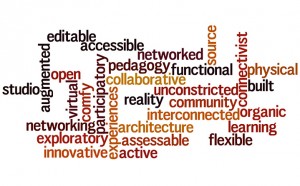Linking Physical and Virtual Learning Environments
Integrative Masters Project Final Document (Released August 31, 2014)
- Access as a PDF file: Linking Physical and Virtual Learning Environments
About the Project
How do we design a 21st Century learning environment that is responsive to the constantly evolving technology landscape and needs of its community of learners? How do the physical and virtual spaces work together to provide a cohesive learning environment that maximizes student impact? What are the best practices for incorporating social learning in education?

This project aims to take the research and methods taught in the program to further expand opportunities for its students. The purpose of this project is to develop collaborative, community driven resources that work cohesively to support the needs of the Educational Technology program. This includes recommendations for utilizing existing campus resources, as well as harnessing appropriate technologies to develop new virtual resources. All facilities (online and physical) will be designed to enhance the program’s ability to forward the School of Education’s core values (scholarship, reflective practice, social justice, inclusive community, wellness, and creativity and the arts).
To allow for continued community collaboration and maximum benefit, I’ve opted to release this document under a Creative Commons Attribution-ShareAlike 4.0 International License. Early drafts of various sections have been released on the AU EdTech Blog as update posts.
Personal Reflections
I had a great experience working on this paper and the accompanying projects. My initial proposal was centered around a more traditional physical learning lab space. However, as I progressed through the research and program assessment, it became clear that developing hybrid/virtual space was both more practical and beneficial given the timeframe. My project advisor, Matt Curinga, was extremely helpful and supportive in allowing me to keep the development fluid.
Going forward I’d like to work with the department to integrate these resources into the program. Ultimately, I hope that this work can serve as a foundation that future students will be able to utilize and build upon.
This article was originally published on October 23, 2014 by Tom Jennings, recent Graduate of the online Masters Program in Educational Technology at Adelphi University.
Back to articles
